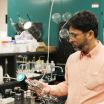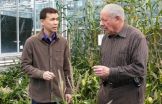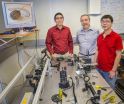(Press-News.org) The U.S. Department of Energy's Ames Laboratory has created a faster, cleaner biofuel refining technology that not only combines processes, it uses widely available materials to reduce costs.
Ames Laboratory scientists have developed a nanoparticle that is able to perform two processing functions at once for the production of green diesel, an alternative fuel created from the hydrogenation of oils from renewable feedstocks like algae.
The method is a departure from the established process of producing biodiesel, which is accomplished by reacting fats and oils with alcohols.
"Conventionally, when you are producing biodiesel from a feedstock that is rich in free fatty acids like microalgae oil, you must first separate the fatty acids that can ruin the effectiveness of the catalyst, and then you can perform the catalytic reactions that produce the fuel," said Ames Lab scientist Igor Slowing. "By designing multifunctional nanoparticles and focusing on green diesel rather than biodiesel, we can combine multiple processes into one that is faster and cleaner." Contrary to biodiesel, green diesel is produced by hydrogenation of fats and oils, and its chemical composition is very similar to that of petroleum-based diesel. Green diesel has many advantages over biodiesel, like being more stable and having a higher energy density.
An Ames Lab research group, which included Slowing, Kapil Kandel, Conerd Frederickson, Erica A. Smith, and Young-Jin Lee, first saw success using bi-functionalized mesostructured nanoparticles. These ordered porous particles contain amine groups that capture free fatty acids and nickel nanoparticles that catalyze the conversion of the acids into green diesel. Nickel has been researched widely in the scientific community because it is approximately 2000 times less expensive as an alternative to noble metals traditionally used in fatty acid hydrogenation, like platinum or palladium.
Creating a bi-functional nanoparticle also improved the resulting green diesel. Using nickel for the fuel conversion alone, the process resulted in too strong of a reaction, with hydrocarbon chains that had broken down. The process, called "cracking," created a product that held less potential as a fuel.
"A very interesting thing happened when we added the component responsible for the sequestration of the fatty acids," said Slowing. "We no longer saw the cracking of molecules. So the result is a better catalyst that produces a hydrocarbon that looks much more like diesel. "
"It also leaves the other components of the oil behind, valuable molecules that have potential uses for the pharmaceutical and food industries," said Slowing.
But Slowing, along with Kapil Kandel, James W. Anderegg, Nicholas C. Nelson, and Umesh Chaudhary, took the process further by using iron as the catalyst. Iron is 100 times cheaper than nickel. Using iron improved the end product even further, giving a faster conversion and also reducing the loss of CO2 in the process.
"As part of the mission of the DOE, we are focused on researching the fundamental science necessary to create the process; but the resulting technology should in principle be scalable for industry," he said.
The process is discussed in a paper, "Bifunctional Adsorbent-Catalytic Nanoparticles for the Refining of Renewable Feedstocks" published in 2013 in ACS Catalysis, and also in "Supported Iron Nanoparticles for the Hydrodeoxygenationof Microalgal Oil to Green Diesel" published in May 2014 in the Journal of Catalysis.
INFORMATION:
A patent application has been filed for this technology; it is available for licensing from the Iowa State University Research Foundation. Further information can be obtained at licensing@iastate.edu.
This research is supported by the U.S. Department of Energy Office of Science. DOE's Office of Science is the single largest supporter of basic research in the physical sciences in the United States, and is working to address some of the most pressing challenges of our time. For more information, please visit science.energy.gov.
Ames Laboratory is a U.S. Department of Energy Office of Science national laboratory operated by Iowa State University. Ames Laboratory creates innovative materials, technologies and energy solutions. We use our expertise, unique capabilities and interdisciplinary collaborations to solve global problems.
Ames Lab creates multifunctional nanoparticles for cheaper, cleaner biofuel
2014-05-12
ELSE PRESS RELEASES FROM THIS DATE:
Mount Sinai researchers identify changes that may occur in neural circuits due to addiction
2014-05-12
A research team from the Friedman Brain Institute of the Icahn School of Medicine at Mount Sinai has published evidence that shows that subtle changes of inhibitory signaling in the reward pathway can change how animals respond to drugs such as cocaine. This is the first study to demonstrate the critical links between the levels of the trafficking protein, the potassium channels' effect on neuronal activity and a mouse's response to cocaine. Results from the study are published in the peer-reviewed journal Neuron on May 7, 2014.
The authors investigated the role of ...
Corn dwarfed by temperature dip suitable for growing in mines, caves
2014-05-12
WEST LAFAYETTE, Ind. - Lowering temperatures for two hours each day reduces the height of corn without affecting its seed yield, a Purdue study shows, a technique that could be used to grow crops in controlled-environment facilities in caves and former mines.
Raising the crops in isolated and enclosed environments would help prevent genetically modified pollen and seed from escaping into the ecosystem and crossing with wild plants.
Cary Mitchell, professor of horticulture, said the technique could be particularly useful for growing transgenic crops to produce high-value ...
INFORMS study: Online buzz forecasts new product performance months before product release
2014-05-12
Companies can significantly improve the forecasting accuracy of forthcoming products' performance by mining online consumer buzz prior to product release, according to a study being published by Marketing Science, a journal of the Institute for Operations Research and the Management Sciences (INFORMS).
Social media attention to a firm's forthcoming products also influences its stock price, the study shows.
Pre-Release Buzz Evolution Patterns and New Product Performance is by Guiyang Xiong and Sundar Bharadwaj, professors at Terry College of Business at the University ...
Potential cure for captive amphibians with chytrid fungus
2014-05-12
Researchers at Vanderbilt University have identified an alternative to a sometimes toxic therapy that protects frogs in zoos from a deadly fungal infection that has been destroying the amphibian populations worldwide. Their research is published ahead of print in Applied and Environmental Microbiology.
The fungal disease, chytridiomycosis, has been decimating frogs all over the world. At present, nothing can help amphibians in the wild, but zoos currently rely on the often-toxic itraconazole to eradicate the disease from infected amphibians they wish to acquire.
To ...
UBC scientists find new way to mobilize immune system against viruses
2014-05-12
University of British Columbia scientists have uncovered an intricate chain reaction in the body's immune system and have used the knowledge to develop a new treatment against harmful viruses.
Viral pandemics, such as the coronavirus that caused the deadly SARS outbreak in 2002, have caused hundreds of deaths in Canada, yet effective anti-viral drugs are rare.
A key element to this natural immune response is an antiviral protein in the blood called Interferon alpha. Like soldiers, Interferon alpha is quickly deployed by the body to fight viruses and removed just as ...
Alcohol and drugs: Not just for modern man
2014-05-12
Unlike modern Man, the prehistoric people of Europe did not use mind-altering substances simply for their hedonistic pleasure. The use of alcohol and plant drugs – such as opium poppies and hallucinogenic mushrooms – was highly regulated and went hand-in-hand with the belief system and sacred burial rituals of many preindustrial societies. Elisa Guerra-Doce of the Universidad de Valladolid in Spain contends that their use was an integral part of prehistoric beliefs, and that these substances were believed to aid in communication with the spiritual world. Guerra-Doce's research ...
All in the rotation
2014-05-12
Viruses are the enigma of the biological world – despite having their own DNA and being able to adapt to their environment and evolve, they are not considered to be alive like cells. In order to reproduce and multiply – a requirement of "life" - a virus must invade a living cell, eject its DNA into that of the cell, and commandeer the cell's biological machinery. While a virus, essentially, may be nothing more than a dollop of DNA packed into a protective coating of protein called a capsid, the packaging of that DNA is critical. The molecular motors that drive this DNA ...
Video stories, other bonding exercises could help foster families connect
2014-05-12
Teenagers and their foster families often say they don't feel connected and have trouble communicating, but few resources exist that nurture their bonding. In a research paper being published in the June issue of Children and Youth Services Review, researchers affiliated with the University of Washington's School of Social Work describe how they tailored a parenting program known to improve communication in non-foster families for use in foster families.
"Every family has its own unique dynamics, such as different rules or expectations. When teens are placed into a foster ...
Two genes together drive aggressive prostate cancer
2014-05-12
NEW YORK, NY (May 12, 2014) —Two genes work together to drive the most lethal forms of prostate cancer, according to new research from the Herbert Irving Comprehensive Cancer Center at Columbia University Medical Center (CUMC). These findings could lead to a diagnostic test for identifying those tumors likely to become aggressive and to the development of novel combination therapy for the disease.
The two genes—FOXM1 and CENPF—had been previously implicated in cancer, but none of the prior studies suggested that they might work synergistically to cause the most aggressive ...
Second opinion changes diagnosis from incurable to curable cancer
2014-05-12
AURORA, Colo. (May 5, 2014) - The Journal of Clinical Oncology reports the case of a woman diagnosed with advanced, incurable lung cancer, whose disease was in fact early stage, curable lung cancer with additional lung lesions due to a rare antibiotic side effect. When her primary lung tumor was surgically removed, and the antibiotic stopped, the 62-year-old woman recovered and may now be cured.
"In a good example of collaboration with our local oncology community, my colleague wanted a second opinion to ensure his patient got the best possible treatment plan established ...


